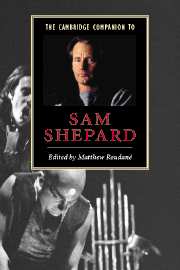Book contents
- Frontmatter
- Introduction
- 1 Born injured
- 2 Shepard and Off-Off-Broadway
- 3 Shepard on Shepard
- 4 A note on Sam Shepard
- 5 Joseph Chaikin and Sam Shepard in collaboration
- 6 Repetition and regression in Curse of the Starving Class and Buried Child
- 7 Shepard writes about writing
- 8 Reflections of the past in True West and A Lie of the Mind
- 9 Patriarchal pathology from The Holy Ghostly to Silent Tongue
- 10 The classic Western and Sam Shepard’s family sagas
- 11 European textures
- 12 Sam Shepard and the cinema
- 13 Sam Shepard as musical experimenter
- 14 Sam Shepard’s nondramatic works
- 15 States of Shock, Simpatico, and Eyes for Consuela
- 16 Sam Shepard’s The Late Henry Moss
- 17 Sam Shepard
- Select bibliography
- Index
Introduction
Published online by Cambridge University Press: 28 May 2006
- Frontmatter
- Introduction
- 1 Born injured
- 2 Shepard and Off-Off-Broadway
- 3 Shepard on Shepard
- 4 A note on Sam Shepard
- 5 Joseph Chaikin and Sam Shepard in collaboration
- 6 Repetition and regression in Curse of the Starving Class and Buried Child
- 7 Shepard writes about writing
- 8 Reflections of the past in True West and A Lie of the Mind
- 9 Patriarchal pathology from The Holy Ghostly to Silent Tongue
- 10 The classic Western and Sam Shepard’s family sagas
- 11 European textures
- 12 Sam Shepard and the cinema
- 13 Sam Shepard as musical experimenter
- 14 Sam Shepard’s nondramatic works
- 15 States of Shock, Simpatico, and Eyes for Consuela
- 16 Sam Shepard’s The Late Henry Moss
- 17 Sam Shepard
- Select bibliography
- Index
Summary
Sam Shepard conferred upon the American stage its postmodernity in the 1960s. Of course he was not the only one to do so, but he interjected a youthful, exuberant, and experimental voice that extended our appreciation of a postmodern aesthetic. In the 2000s, Shepard continues experimenting with dramatic form and structure. He traverses the borders of faith, logic, and social coherence to reconnoiter a mythic and cultural terrain filled with uncertainty and the near-absence of love. His is a Zolaesque world, a malevolent universe in which a sense of bafflement and loss prevail. As Baylor says in A Lie of the Mind (1985), “We're all gonna get clobbered when we least expect it.” Contextualized within a narrative history of the American theatre, seeing characters “clobbered” on stage is hardly unique. From Susan Glaspell and Eugene O'Neill to Edward Albee and Adrienne Kennedy, American playwrights have presented a rich, if disturbing, series of physical, psychological, and moral assaults. Still, within the works of many twentieth-century American playwrights - Arthur Miller's The Crucible (1953), O'Neill's Long Day's Journey into Night (1956), Lorraine Hansberry's A Raisin in the Sun (1959), Marsha Norman's Getting Out (1977), Tony Kushner's companion plays, Angels in America (parts One and Two, 1991, 1992), and Margaret Edson's Wit (1999) - there is more often than not an implied sense of recovery, or some epiphanic coming to terms with one's self and culture. Or if it is too late for a John Proctor or Mary Tyrone, perhaps the spark of recognition transpires within the audience. For many American dramatists, confrontation triggers catharsis, catharsis insight, and that insight becomes a still point whose defining moment, itself, is the mechanism for a transcendent awareness, signaling the first step toward a spiritual recovery of the self.
- Type
- Chapter
- Information
- The Cambridge Companion to Sam Shepard , pp. 1 - 6Publisher: Cambridge University PressPrint publication year: 2002
- 3
- Cited by



